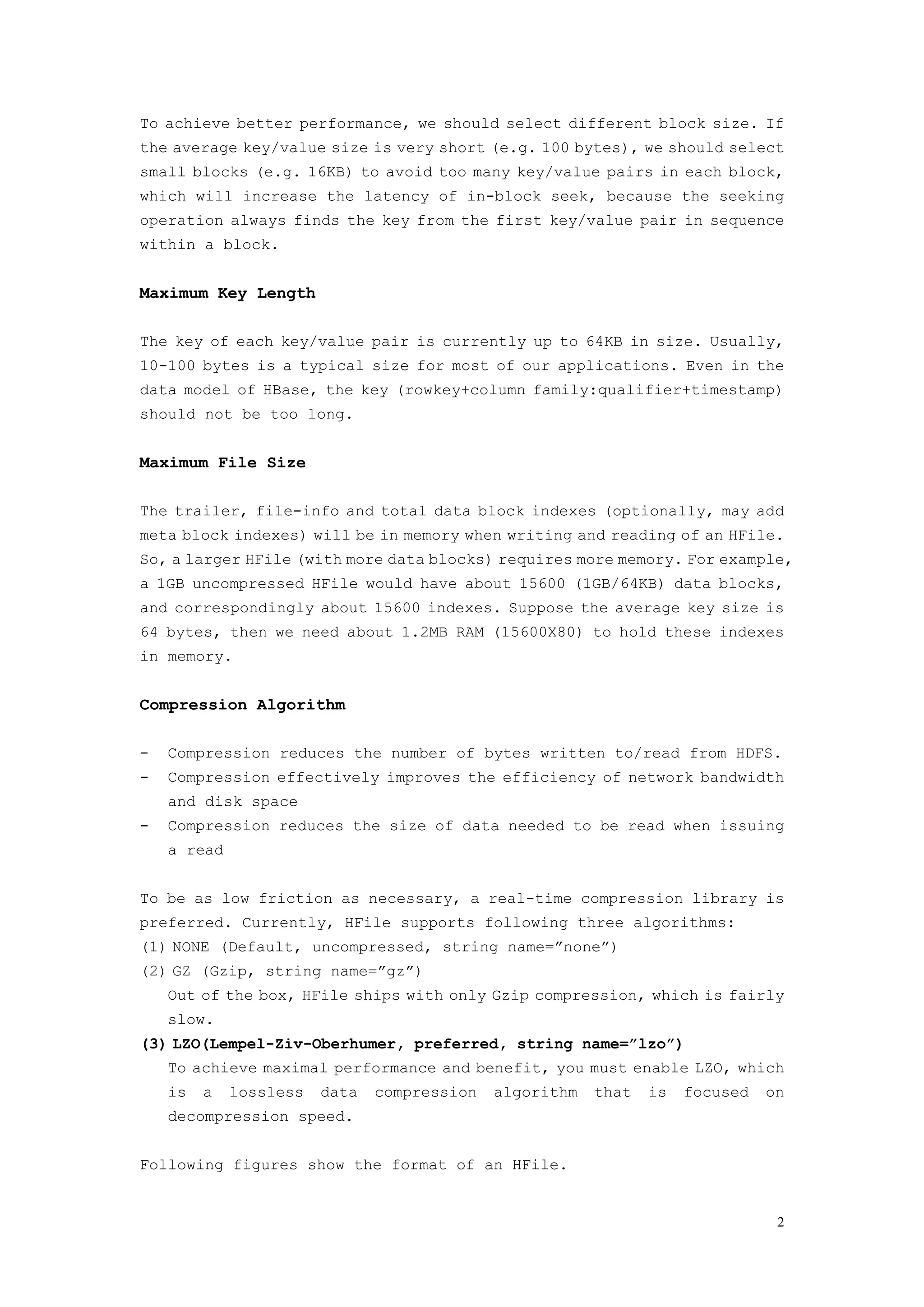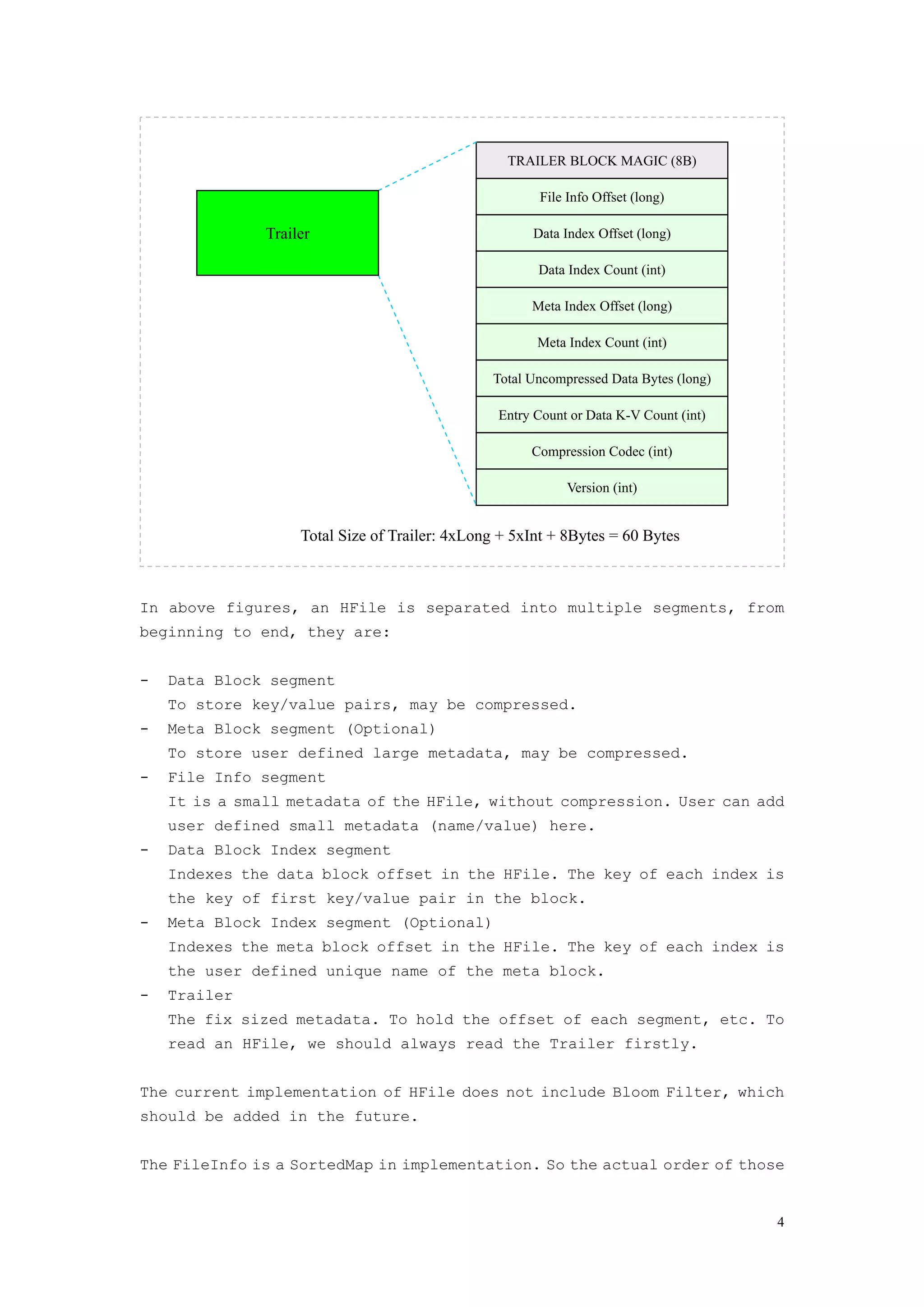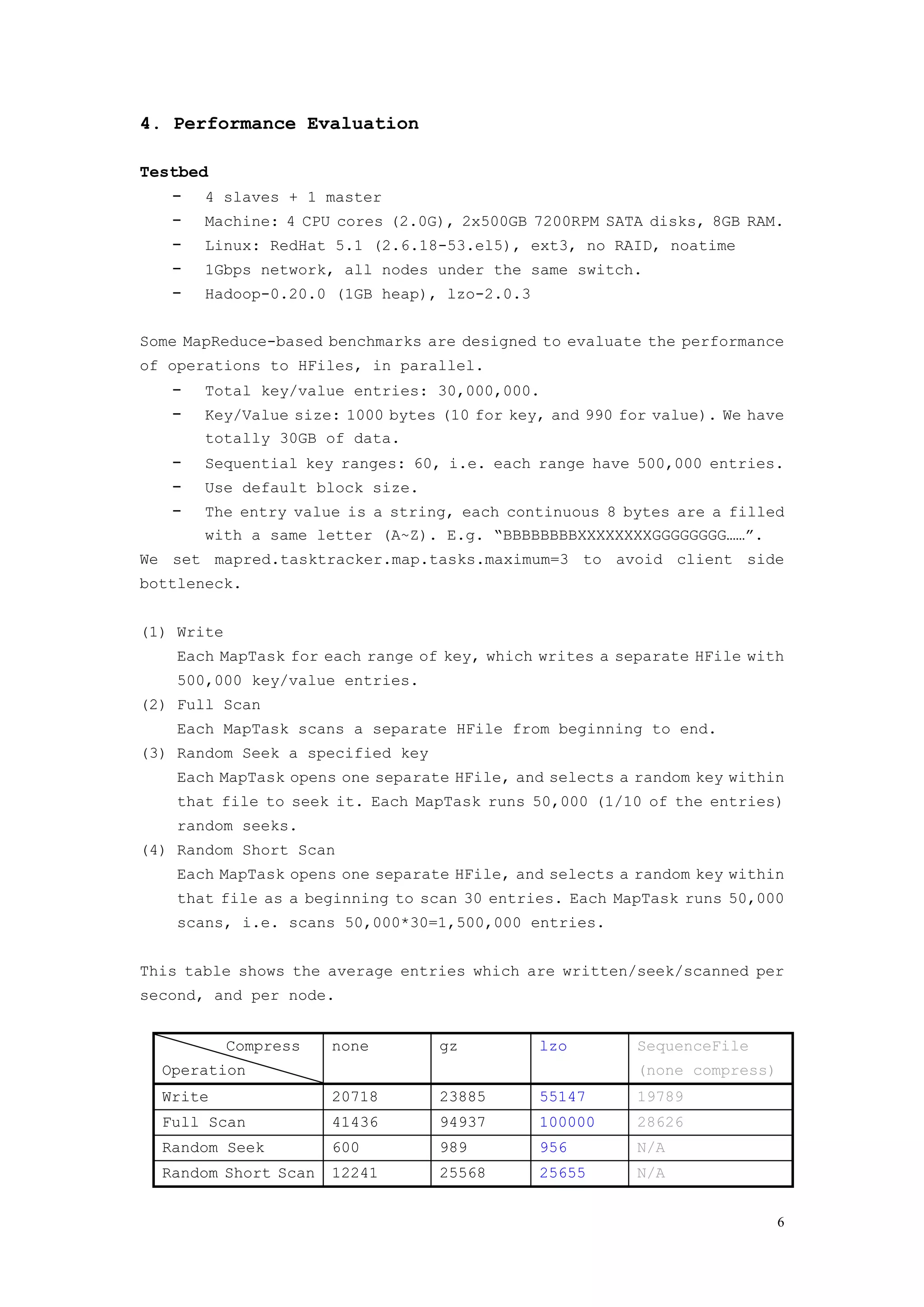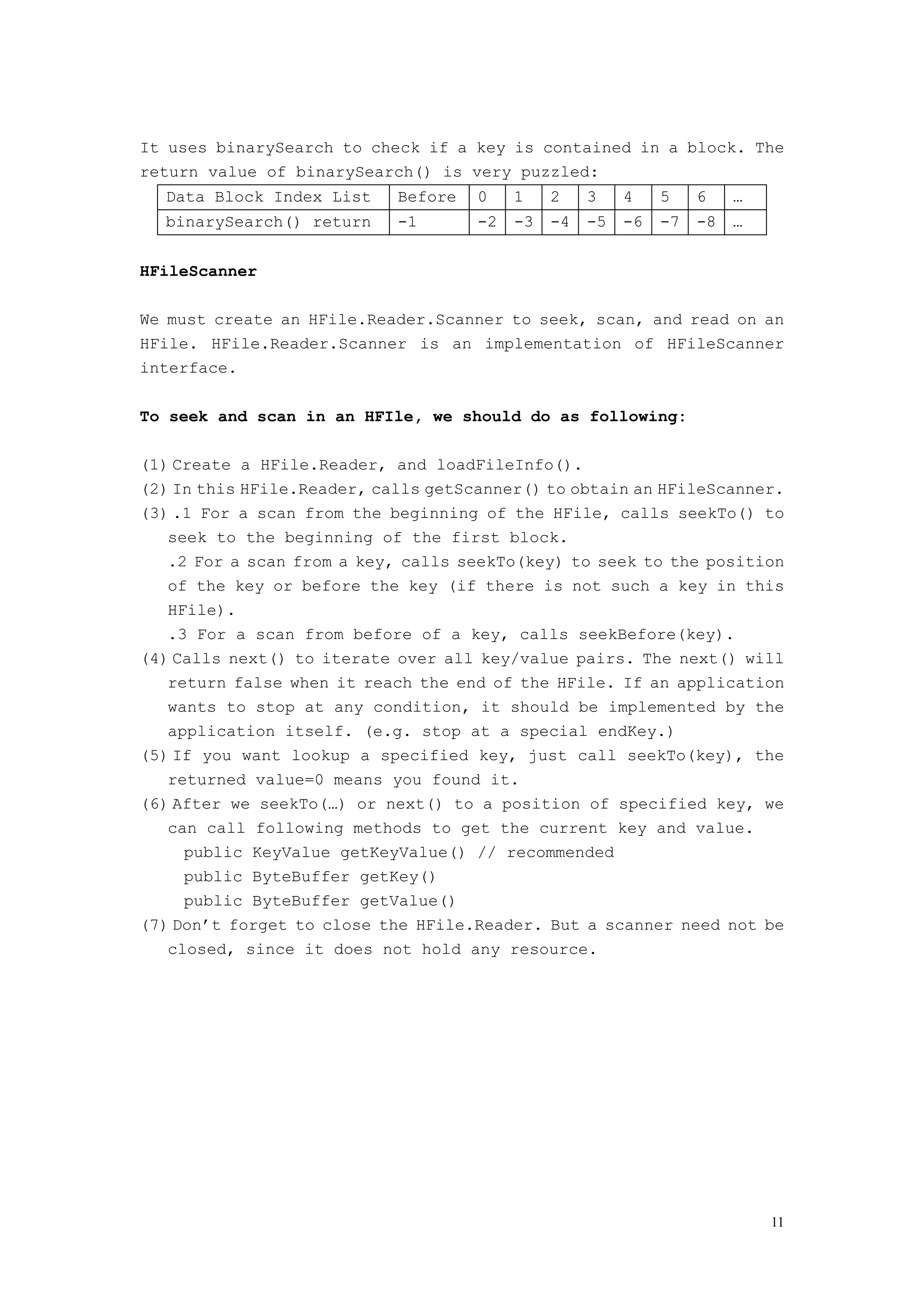HFile is a block-indexed file format designed for storing sorted key-value pairs, modeled after Google's SSTable and implemented in Hadoop HBase. It employs data blocks (default 64KB) and supports various compression algorithms, with LZO being preferred for performance. The document details the file structure, compression options, and performance evaluations, indicating that HFile may outperform traditional SequenceFiles in MapReduce environments.
![HFile: A Block-Indexed File Format
to Store Sorted Key-Value Pairs
Sep 10, 2009 Schubert Zhang (schubert.zhang@gmail.com) http://cloudepr.blogspot.com
1. Introduction
HFile is a mimic of Google’s SSTable. Now, it is available in Hadoop
HBase-0.20.0. And the previous releases of HBase temporarily use an
alternate file format – MapFile[4], which is a common file format in Hadoop
IO package. I think HFile should also become a common file format when
it becomes mature, and should be moved into the common IO package of Hadoop
in the future.
Following words of SSTable are from section 4 of Google’s Bigtable paper.
The Google SSTable file format is used internally to store Bigtable data.
An SSTable provides a persistent, ordered immutable map from keys to values,
where both keys and values are arbitrary byte strings. Operations are
provided to look up the value associated with a specified key, and to
iterate over all key/value pairs in a specified key range. Internally,
each SSTable contains a sequence of blocks (typically each block is 64KB
in size, but this is configurable). A block index (stored at the end of
the SSTable) is used to locate blocks; the index is loaded into memory
when the SSTable is opened. A lookup can be performed with a single disk
seek: we first find the appropriate block by performing a binary search
in the in-memory index, and then reading the appropriate block from disk.
Optionally, an SSTable can be completely mapped into memory, which allows
us to perform lookups and scans without touching disk.[1]
The HFile implements the same features as SSTable, but may provide more
or less.
2. File Format
Data Block Size
Whenever we say Block Size, it means the uncompressed size.
The size of each data block is 64KB by default, and is configurable in
HFile.Writer. It means the data block will not exceed this size more than
one key/value pair. The HFile.Writer starts a new data block to add
key/value pairs if the current writing block is equal to or bigger than
this size. The 64KB size is same as Google’s [1].
1](https://image.slidesharecdn.com/hfile-090911130852-phpapp02/75/HFile-A-Block-Indexed-File-Format-to-Store-Sorted-Key-Value-Pairs-1-2048.jpg)

![KeyLen (int) ValLen (int) Key (byte[]) Value (byte[])
Data Block 0
DATA BLOCK MAGIC (8B)
Key-Value (First)
Data Block 1
……
Key-Value (Last)
Data Block 2
KeyLen Key id ValLen Val
(vint) (byte[]) (1B) (vint) (byte[])
Meta Block 0
(Optional) User Defined Metadata,
start with METABLOCKMAGIC
Meta Block 1 Size or ItemsNum (int)
(Optional)
LASTKEY (byte[])
AVG_KEY_LEN (int)
File Info
AVG_VALUE_LEN (int)
COMPARATOR (className)
User Defined
Data Index
INDEX BLOCK MAGIC (8B)
Meta Index Index of Data Block 0
(Optional)
…
Trailer INDEX BLOCK MAGIC (8B)
Index of Meta Block 0
…
Fixed File Trailer
(Go to next picture)
Offset(long) MetaSize (int) MetaNameLen (vint) MetaName (byte[])
Offset(long) DataSize (int) KeyLen (vint) Key (byte[])
3](https://image.slidesharecdn.com/hfile-090911130852-phpapp02/75/HFile-A-Block-Indexed-File-Format-to-Store-Sorted-Key-Value-Pairs-3-2048.jpg)

![fields is alphabetically based on the key.
3. LZO Compression
LZO is now removed from Hadoop or HBase 0.20+ because of GPL restrictions.
To enable it, we should install native library firstly as following.
[6][7][8][9]
(1) Download LZO: http://www.oberhumer.com/, and build.
# ./configure --build=x86_64-redhat-linux-gnu --enable-shared
--disable-asm
# make
# make install
Then the libraries have been installed in: /usr/local/lib
(2) Download the native connector library
http://code.google.com/p/hadoop-gpl-compression/, and build.
Copy hadoo-0.20.0-core.jar to ./lib.
# ant compile-native
# ant jar
(3) Copy the native library (build/native/ Linux-amd64-64) and
hadoop-gpl-compression-0.1.0-dev.jar to your application’s lib
directory. If your application is a MapReduce job, copy them to
hadoop’s lib directory. Your application should follow the
$HADOOP_HOME/bin/hadoop script to ensure that the native hadoop
library is on the library path via the system property
-Djava.library.path=<path>. [9] For example:
# setup 'java.library.path' for native-hadoop code if necessary
JAVA_LIBRARY_PATH=''
if [ -d "${HADOOP_HOME}/build/native" -o -d "${HADOOP_HOME}/lib/native" ]; then
JAVA_PLATFORM=`CLASSPATH=${CLASSPATH} ${JAVA} -Xmx32m
org.apache.hadoop.util.PlatformName | sed -e "s/ /_/g"`
if [ -d "$HADOOP_HOME/build/native" ]; then
JAVA_LIBRARY_PATH=${HADOOP_HOME}/build/native/${JAVA_PLATFORM}/lib
fi
if [ -d "${HADOOP_HOME}/lib/native" ]; then
if [ "x$JAVA_LIBRARY_PATH" != "x" ]; then
JAVA_LIBRARY_PATH=${JAVA_LIBRARY_PATH}:${HADOOP_HOME}/lib/native/${JAVA_PLATFORM}
else
JAVA_LIBRARY_PATH=${HADOOP_HOME}/lib/native/${JAVA_PLATFORM}
fi
fi
fi
Then our application and hadoop/MapReduce can use LZO.
5](https://image.slidesharecdn.com/hfile-090911130852-phpapp02/75/HFile-A-Block-Indexed-File-Format-to-Store-Sorted-Key-Value-Pairs-5-2048.jpg)

![In this evaluation case, the compression ratio is about 7:1 for gz(Gzip),
and about 4:1 for lzo. Even through the compression ratio is just moderate,
the lzo column shows the best performance, especially for writes.
The performance of full scan is much better than SequenceFile, so HFile
may provide better performance to MapReduce-based analytical
applications.
The random seek in HFiles is slow, especially in none-compressed HFiles.
But the above numbers already show 6X~10X better performance than a disk
seek (10ms). Following Ganglia charts show us the overhead of load, CPU,
and network. The random short scan makes the similar phenomena.
5. Implementation and API
5.1 HFile.Writer : How to create and write an HFile
(1) Constructors
There are 5 constructors. We suggest using following two:
public Writer(FileSystem fs, Path path, int blocksize,
String compress,
final RawComparator<byte []> comparator)
public Writer(FileSystem fs, Path path, int blocksize,
Compression.Algorithm compress,
final RawComparator<byte []> comparator)
These two constructors are same. They create file (call fs.create(…)) and
get an FSDataOutputStream for writing. Since the FSDataOutputStream is
7](https://image.slidesharecdn.com/hfile-090911130852-phpapp02/75/HFile-A-Block-Indexed-File-Format-to-Store-Sorted-Key-Value-Pairs-7-2048.jpg)
![created when constructing the HFile.Writer, it will be automatically
closed when the HFile.Writer is closed.
The other two constructors provide FSDataOutputStream as a parameter. It
means the file is created and opened outside of the HFile.Writer, so, when
we close the HFile.Writer, the FSDataOutputStream will not be closed. But
we do not suggest using these two constructors directly.
public Writer(final FSDataOutputStream ostream, final int blocksize,
final String compress,
final RawComparator<byte []> c)
public Writer(final FSDataOutputStream ostream, final int blocksize,
final Compression.Algorithm compress,
final RawComparator<byte []> c)
Another constructor only provides fs and path as parameters, all other
attributes are default, i.e. NONE of compression, 64KB of block size, raw
ByteArrayComparator, etc.
(2) Write Key/Value pairs into HFile
Before key/value pairs are written into an HFile, the application must
sort them using the same comparator, i.e. all key/value pairs must be
sequentially and increasingly write/append into an HFile. There are
following methods to write/append key/value pairs:
public void append(final KeyValue kv)
public void append(final byte [] key, final byte [] value)
public void append(final byte [] key, final int koffset, final int klength,
final byte [] value, final int voffset, final int vlength)
When adding a key/value pair, they will check the current block size. If
the size reach the maximum size of a block, the current block will be
compressed and written to the output stream (of the HFile), and then create
a new block for writing. The compression is based on each block. For each
block, an output stream for compression will be created from beginning
of a new block and released when finish.
Following chart is the relationship of the output steams OO design:
8](https://image.slidesharecdn.com/hfile-090911130852-phpapp02/75/HFile-A-Block-Indexed-File-Format-to-Store-Sorted-Key-Value-Pairs-8-2048.jpg)
![DataOutputStream
BufferedOutputStream
FinishOnFlushCompressionStream
Compression?OutputStream
(for different codec)
FSDataOutputStream
(to an HFile)
The key/value appending operation is written from the outside
(DataOutputStream), and the above OO mechanism will handle the buffer and
compression functions and then write to the file in under layer file system.
Before a key/value pair is written, following will checked:
- The length of Key
- The order of Key (must bigger than the last one)
(3) Add metadata into HFile
We can add metadata block into an HFile.
public void appendMetaBlock(String metaBlockName, byte [] bytes)
The application should provide a unique metaBlockName for each metadata
block within an HFile.
Reminding: If your metadata is large enough (e.g. 32KB uncompressed), you
can use this feature to add a separate meta block. It may be compressed
in the file.
But if your metadata is very small (e.g. less than 1KB), please use
following method to append it into file info. File info will not be
compressed.
public void appendFileInfo(final byte [] k, final byte [] v)
(4) Close
Before the HFile.Writer is closed, the file is not completed written. So,
we must call close() to:
- finish and flush the last block
9](https://image.slidesharecdn.com/hfile-090911130852-phpapp02/75/HFile-A-Block-Indexed-File-Format-to-Store-Sorted-Key-Value-Pairs-9-2048.jpg)
![- write all meta block into file (may be compressed)
- generate and write file info metadata
- write data block indexes
- write meta block indexes
- generate and write trailer metadata
- close the output-stream.
5.2 HFile.Reader: How to read HFile
Create an HFile.Reader to open an HFile, and we can seek, scan and read
on it.
(1) Constructor
We suggest using following constructor to create an HFile.Reader.
public Reader(FileSystem fs, Path path, BlockCache cache,
boolean inMemory)
It calls fs.open(…) to open the file, and gets an FSDataInputStream
for reading. The input stream will be automatically closed when the
HFile.Reader is closed.
Another constructor uses InputStream as parameter directly. It means
the file is opened outside the HFile.Reader.
public Reader(final FSDataInputStream fsdis, final long size,
final BlockCache cache, final boolean inMemory)
We can use BlockCache to improve the performance of read, and the mechanism
of mechanism will be described in other document.
(2) Load metadata and block indexes of an HFile
The HFile is not readable before loadFileInfo() is explicitly called .
It will read metadata (Trailer, File Info) and Block Indexes (data
block and meta block) into memory. And the COMPARATOR instance will
reconstruct from file info.
BlockIndex
The important method of BlockIndex is:
int blockContainingKey(final byte[] key, int offset, int length)
10](https://image.slidesharecdn.com/hfile-090911130852-phpapp02/75/HFile-A-Block-Indexed-File-Format-to-Store-Sorted-Key-Value-Pairs-10-2048.jpg)

![References
[1] Google, Bigtable: A Distributed Storage System for Structured Data,
http://labs.google.com/papers/bigtable.html
[2] HBase-0.20.0 Documentation,
http://hadoop.apache.org/hbase/docs/r0.20.0/
[3] HFile code review and refinement.
http://issues.apache.org/jira/browse/HBASE-1818
[4] MapFile API:
http://hadoop.apache.org/common/docs/current/api/org/apache
/hadoop/io/MapFile.html
[5] Parallel LZO: Splittable Compression for Hadoop.
http://www.cloudera.com/blog/2009/06/24/parallel-lzo-splitt
able-compression-for-hadoop/
http://blog.chrisgoffinet.com/2009/06/parallel-lzo-splittab
le-on-hadoop-using-cloudera/
[6] Using LZO in Hadoop and HBase:
http://wiki.apache.org/hadoop/UsingLzoCompression
[7] LZO: http://www.oberhumer.com
[8] Hadoop LZO native connector library:
http://code.google.com/p/hadoop-gpl-compression/
[9] Hadoop Native Libraries Guide:
http://hadoop.apache.org/common/docs/r0.20.0/native_librari
es.html
12](https://image.slidesharecdn.com/hfile-090911130852-phpapp02/75/HFile-A-Block-Indexed-File-Format-to-Store-Sorted-Key-Value-Pairs-12-2048.jpg)